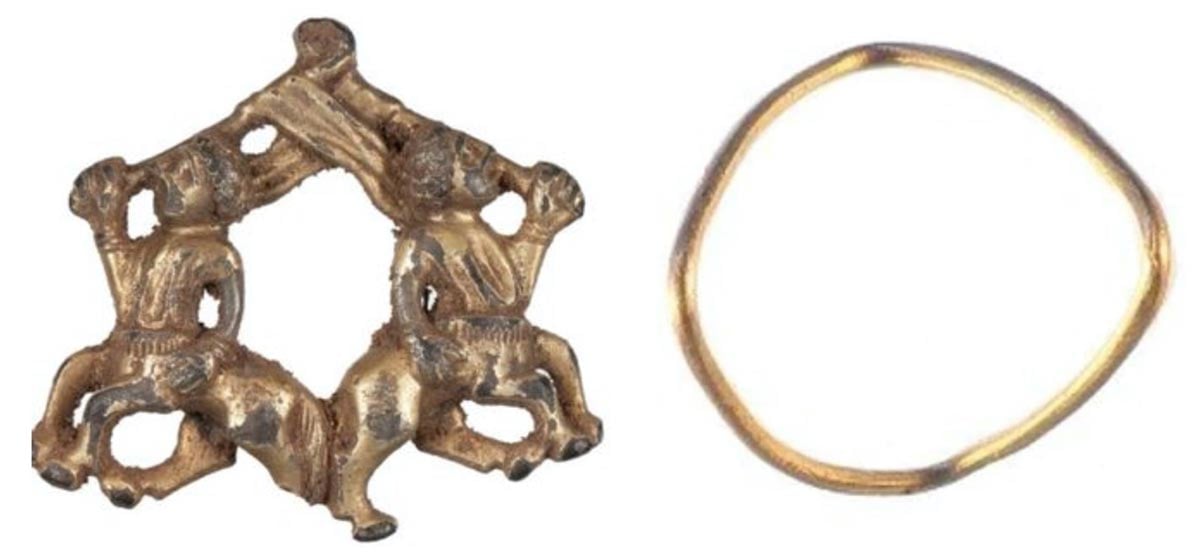Detectorists Unearth Rare Iron Age and Medieval Jewelry in England
In Britain, metal detectorists have unearthed two historically significant treasures and in particular, very rare pieces of Iron Age and medieval jewelry. One is a gold ring and the other is a brooch depicting a mythical creature, which is highly unusual. These finds may help researchers to better understand the two very different eras. The two enthusiasts who found the treasures may reap substantial financial rewards.
The artifacts were discovered by two metal detectorists Mark Lambert and Christopher Mussell in Shropshire, England. They handed over their finds to the relevant authorities as required under the Treasure Act (1996), and the two artifacts have been recorded by the Portable Antiquities Scheme that catalogues archaeological finds made by detectorists and members of the public.
Throwing a Light on Iron Age England
The Iron Age ring was unearthed by Christopher Mussell, at Frodesley in the south of Shropshire. It is made of gold and despite being somewhat bent is in a remarkable condition. Experts from the Portable Antiquities Scheme have stated that the precious item dates to between 400 and 200 BC. The finds liaison officer for the area, Peter Reavill, told the BBC that Iron Age gold rings are “exceedingly rare.”

The gold Iron Age ring unearthed in England. (British Museum’s Portable Antiquities Scheme)
They established that the ring was only the sixth of its kind ever found in the entire country and is similar to ones found in Switzerland. The Daily Mail quotes experts from the Portable Antiquities Scheme as saying that “given this, it is possible that the ring was either imported from the continent or made as a local copy.” The discovery of the ring may indicate that there were extensive trade networks that crisscrossed the European continent and even reached England.
Understanding Iron Age Society
Based on archaeological sites such as hill-top forts, we know that England in the Iron Age was a rich and densely populated area, but we know very little about how people lived because so few of their personal possessions have been recovered.
Mr. Reavill is quoted by The Daily Mail saying “what we don't have is a great understanding of where these people lived, traded and farmed.” The ring can help us to understand the society of the wearer of the ring. The Daily Mail reports Mr. Reavill as saying that the discovery “throws a beam of light on to the individual who once wore it.”
Rare Medieval Jewelry With Mythical Creatures
The medieval brooch was found at a location near Bridgnorth, Shropshire by Mark Lambert. It is a silver-gilt item, and it consists of two intricately carved centaurs, that are holding a banner or flag. The centaurs were half-men and half-horses from Greek mythology.

The medieval jewelry (brooch) was found near Bridgnorth in Shropshire by metal detectorist Mark Lambert. (Mark Lambert)
- How Two Women Pulled Off a Medieval Manuscript Heist in Post-War Germany
- Stunning Celtic Horse Harness Became Treasured Brooch of Norwegian Viking Woman
- After 20 Years, Amateur Metal Detecting Friends Find the Oldest Iron Age Gold Jewelry in Britain
The original pin of the brooch is missing, but it is believed that it once was looped around one of the mythical figures. Alternatively, it may have been sewn onto a piece of clothing like a badge. Mr. Reavill told the BBC that “the brooch has hardly any wear on it and looks almost as good as the day it was lost some 800 years ago.”

The medieval jewelry (brooch) that dates from 1200 - 1300AD, from the front and back. (British Museum’s Portable Antiquities Scheme)
Declarations as Treasure
The items were declared as treasure by Coroner John Ellery at the sitting of a court in Shropshire on April 21, 2020. This was something of a first, because it was held via video links due to the current restrictions as a result of the coronavirus pandemic. This means that museums can now bid for the items at a price guide that is set by a panel of experts. The local Shropshire Museum is very keen to secure the objects and put them on public display.
According to the Treasure Act of 1996, the sum that a museum pays for an item can be awarded in full to those who found the tiny treasures. This means that the two detectorists are possibly going to be in for a financial windfall. However, they may have to share their reward with the owners of the land where the items were unearthed.
Top image: The Iron Age and medieval jewelry unearthed in Shropshire, England. Left: the medieval brooch with centaurs. Right: The gold Iron Age ring. Source: British Museum’s Portable Antiquities Scheme
By Ed Whelan



















